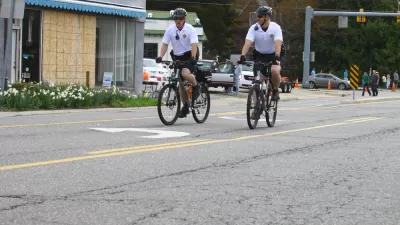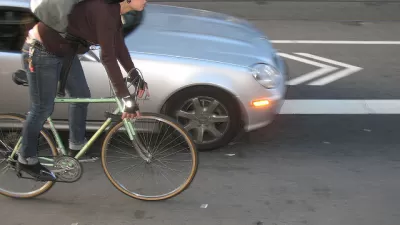Sharrows and 3-foot passing laws are meant to make biking safer in streets in the absence of bike lanes. Bike activists in Iowa want to take safety a step further by requiring motorists to move to another lane, just as they would if passing a car.
The bill, known as "Change Lanes to Pass Bicyclists" or Senate File (SF) 2224 "would require motor vehicles to use the opposite side of the road or an adjacent travel lane to pass people on bicycles," states the legislative page of the Iowa Bicycle Coalition "It also recognizes that paved shoulders and bike lanes are adjacent travel lanes, and prohibits motorists from steering unreasonable close to people riding bicycles in those lanes."
Current Iowa law "prohibits motorists from driving 'unreasonably close' to cyclists," writes Molly Montag of the Globe Gazette. Last year 26 states plus the District of Columbia passed laws requiring motorists to pass no less than three feet from a cyclist, according to the National Conference of State Legislatures.

Credit: NCSL, Safely Passing Bicyclists Chart, 12/17/2015
"Approximately half of Iowa cyclists killed in the past 10 years have been hit during passing incidents, said Iowa Bicycle Coalition Executive Director Mark Wyatt," writes Montag.
“We want the law very crystal clear that you pass a bicycle like you would pass any other vehicle on the roadway,” Wyatt said.
SF 2224 passed the Transportation Committee, 12-0 and the Senate, 38-12, and now advances to the House, according to Iowa Bicycle Coalition webpage. The Iowa Chapter of the Sierra Club is supporting the bill [PDF].
Another safety strategy is to add sharrows to the asphalt along with roadway signs indicating to both cyclists and motorists that the both are to share the lane. While better than no such signs, many question their effectiveness to improve safety and increase cycling.
Credit: Bike Arlington

Readers can listen to a 49-minute talk with Mark Wyatt on bike culture in the Hawkeye State on Iowa Public Radio. The "Talk of Iowa" show was aired last September followed the tragic death of a cyclist by a drunk driver.
Hat tip to AASHTO Daily Transportation Update.
FULL STORY: Proposed bicycle safety law much needed, North Iowa cyclists say

Study: Maui’s Plan to Convert Vacation Rentals to Long-Term Housing Could Cause Nearly $1 Billion Economic Loss
The plan would reduce visitor accommodation by 25,% resulting in 1,900 jobs lost.

Alabama: Trump Terminates Settlements for Black Communities Harmed By Raw Sewage
Trump deemed the landmark civil rights agreement “illegal DEI and environmental justice policy.”

Why Should We Subsidize Public Transportation?
Many public transit agencies face financial stress due to rising costs, declining fare revenue, and declining subsidies. Transit advocates must provide a strong business case for increasing public transit funding.

Paris Bike Boom Leads to Steep Drop in Air Pollution
The French city’s air quality has improved dramatically in the past 20 years, coinciding with a growth in cycling.

Why Housing Costs More to Build in California Than in Texas
Hard costs like labor and materials combined with ‘soft’ costs such as permitting make building in the San Francisco Bay Area almost three times as costly as in Texas cities.

San Diego County Sees a Rise in Urban Coyotes
San Diego County experiences a rise in urban coyotes, as sightings become prevalent throughout its urban neighbourhoods and surrounding areas.
Urban Design for Planners 1: Software Tools
This six-course series explores essential urban design concepts using open source software and equips planners with the tools they need to participate fully in the urban design process.
Planning for Universal Design
Learn the tools for implementing Universal Design in planning regulations.
Smith Gee Studio
Alamo Area Metropolitan Planning Organization
City of Santa Clarita
Institute for Housing and Urban Development Studies (IHS)
City of Grandview
Harvard GSD Executive Education
Toledo-Lucas County Plan Commissions
Salt Lake City
NYU Wagner Graduate School of Public Service





























